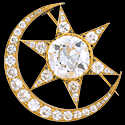
Nizam Jewelry - 1

Nizam's
jewels - timeless treasures of India
Just the fact that
there is jewellery worth over Rs.15,000 crore under one roof is staggering. Even
if one doesn't consider the cost, the sheer magnificence of each of the
exhibited pieces is enough to leave one speechless with awe and wonder. In
Hyderabad, which is keeping up to its reputation of being a happening city, the
two- month long exhibition of diamonds, rubies, emeralds, sapphires and pearls,
resplendent in all their glitter and colour, re-kindle memories of Hyderabad
heritage. Belonging to the Asaf Jah dynasty, which was established in 1724, the
jewellery has a historic past, and a colourful one at that.
It was in 1972 that the
jewels of the Nizams of Hyderabad, rumoured to be one of the most exceptional
collection, were offered for sale to the Government of India for Rupees 218
crore. The deal was struck. However, it has taken almost 23 years to finally
acquire the jewels, after prolonged court cases and colossal expenses.
First, the jewels were
shifted to the vaults of the Reserve Bank of India from the Hongkong Bank where
they were being held earlier. Later, the jewellery was exhibited for the first
time at the National Museum in New Delhi for about two months during September -
December, 2001.
The 173 piece collection
was built up over seven generations of the Asaf Jabs or the Nizams as rulers
were called. Although the Nizams ruled over the Deccan, they had adopted the
lifestyle, court traditions and administrative practices of the Mughals.
The jewellery, therefore, is a synthesis of Mughal, deccani, as well as European influences. It reflects the ethos of a dynasty that originated in the Mughal court, ruled the Deccan and was a staunch ally of the British empire. It was during the seventh and the last Nizam's -Mir Osman Ali Khan- time that care was taken to preserve the timeless treasure. It was difficult for the Nizams, who had a large family and a retinue of servants, to take of their own.
It was then that Mir Osman
Ali Khan, with a view to safeguarding this fabulous wealth, started liquidating
a portion of his astronomical fortune and allocated it to a series of trusts.
The most unique of these was the Nizam Jewellery Trust, being the only one to
have been established by an Indian ruler. He also created a supplementary
Jewellery Trust, incorporated in 1951, being the only one to have been
established by an Indian ruler. He also created another supplementary Jewellery
Trust after allocating gifts to his grandsons in 1952. The trustees kept this
treasure of great historical value in the vaults of the Hongkong Bank.
The present collection
comprises a total of 173 items. The actual number of the pieces is 325 (counting
individual pieces and not as pairs) excluding about 22 unset emeralds and the
legendary Jacob diamond.
The collection includes a
number of sarpench (bejew-elled headgear), necklaces, waist-belts, buckles,
brace-lets, anklets, armlets, toe-rings, finger -rings, pocket watches, watch
chains, buttons and cuff-links, to name but a few. All the jewels are
flamboyant, yet, there are certain pieces which stand out for their unique
quality, size and colour, and most importantly, for their workmanship.
Most of the diamonds used
in the jewellery came from the mines in Golconda which were owned by the Nizams.
This is one reason why all the pieces invariably have diamonds that are either
uncut or cut into magnificent pieces by the local artisans. The luster and
brilliance of the Golconda diamonds is most apparent in the sarpenchs,
especially those that are to be worn over the headgear. These are in gold, set
with diamonds, emerald beads and cabochon rubies. There is a very special
sarpench which was made for a young prince, Mahabub Ali, when he ascended the
throne. It is called 'Bachkana sarpench' and has been chosen to be the logo of
the exhibition. The brilliance of Golconda diamonds set in this piece outshines
that in any other piece. A solitaire set in gold, with five smaller diamonds on
each side, has on its top an exquisite bird crafted with small diamonds for its
plumage and a ruby as its eye. Interestingly, the bird holds a tiny 'taveez'
(lucky charm) in its beak.
The organisers at
Salarjung Museum have provided the perfect ambience for display of these
priceless jewels. These have been placed in a specially built hall decorated
with chandeliers, modern lighting and lush carpets. The ornaments have been
illuminated with optic - fibre spot lights and are showcased behind bullet-proof
glass. This royal collection is the only one of its kind owned by the Government
of India.
Among the exhibited pieces, the imperial diamond, known as Jacob diamond, is a fabulour piece, Weighing 184.75 carats, this sparkling beauty is double the size of the Koh-i-Noor diamond and is said to be the seventh largest in the world. It was acquired by the sixth Nizam, Mir Mahabub Ali Pasha in 1891 from a Jewish trader, A.K. Jacob and hence the name. - (India Perspectives)






